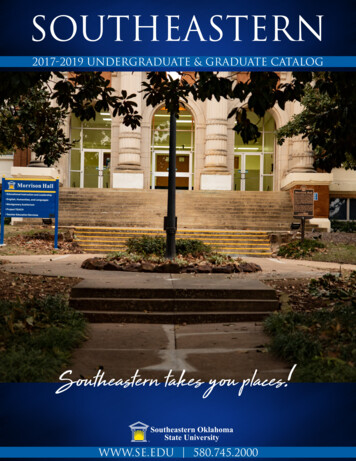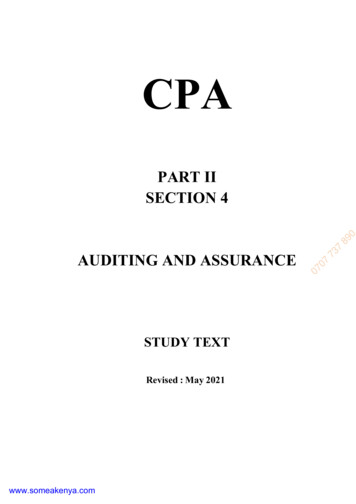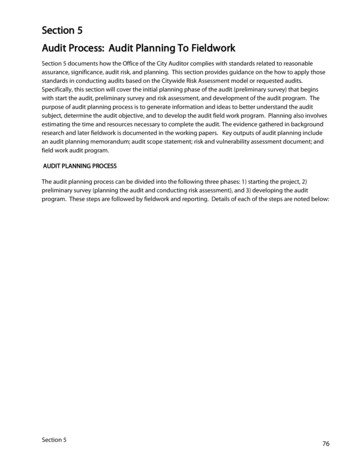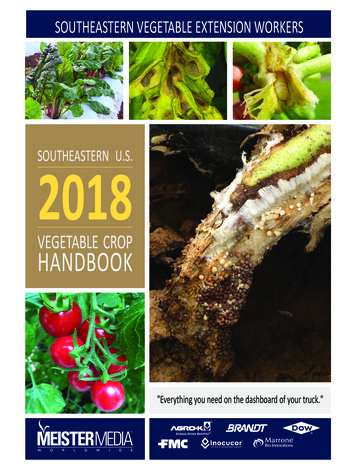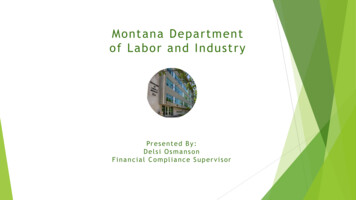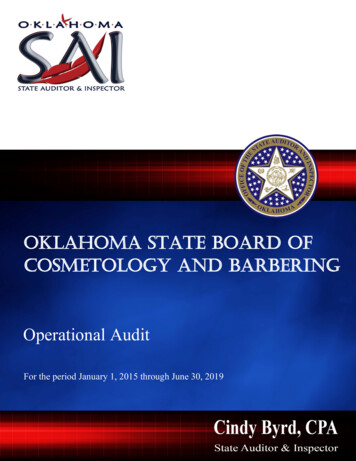
Transcription
Oklahoma state Board ofcosmetology and barberingOperational AuditFor the period January 1, 2015 through June 30, 2019
Audit Report of theOklahoma State Board of Cosmetology and BarberingFor the PeriodJanuary 1, 2015 through June 30, 2019This publication, issued by the Oklahoma State Auditor and Inspector’s Office as authorized by 74 O.S. § 212, has notbeen printed, but is available on the agency’s website (www.sai.ok.gov) and in the Oklahoma Department ofLibraries Publications Clearinghouse Digital Prairie Collection audits/search), pursuant to 65 O.S. § 3-114.
January 22, 2020To the Oklahoma State Board of Cosmetology and BarberingWe present the audit report of the Oklahoma State Board of Cosmetology and Barbering for theperiod January 1, 2015 through June 30, 2019. The goal of the State Auditor and Inspector is topromote accountability and fiscal integrity in state and local government. Maintaining ourindependence as we provide this service to the taxpayers of Oklahoma is of utmost importance.We wish to take this opportunity to express our appreciation for the assistance and cooperationextended to our office during our engagement.This report is a public document pursuant to the Oklahoma Open Records Act (51 O.S. § 24A.1et seq.), and shall be open to any person for inspection and copying.Sincerely,CINDY BYRD, CPAOKLAHOMA STATE AUDITOR & INSPECTOR
Oklahoma State Board of Cosmetology and BarberingOperational AuditBackgroundThe State Board of Cosmetology was created by the OklahomaLegislature in 1935, primarily as a self-sustaining licensing agency.Recreated in 2014 as the Oklahoma State Board of Cosmetology andBarbering (the Agency), the entity licenses and regulates the professionsof cosmetology, barbering, esthetics, and manicuring, and the instructorsand establishments where these services are performed. It also regulateshealth and safety issues in schools approved by the Board. Anyone whoprovides these types of services, including but not limited to haircutting,hairdressing, nail care, skin care, and the application of make-up, must belicensed by the Board.The Agency’s mission is to safeguard and protect the health and generalwelfare of the people of the state of Oklahoma by performing a variety ofservices from developing curriculum for schools to administeringexaminations for prospective practitioners of the cosmetology, barbering,and massage therapy profession.The Agency is overseen by an eleven-member board (the Board).Members as of November 2019 are:Jeffrey Sells . ChairMachele Callicoat . Vice-ChairLaFaye Austin. MemberPeggy Avery . MemberAnthony Baldini . MemberBill Helton . MemberChristie Luther . MemberChristy Mather . MemberGreg Mitchell . MemberThao Nguyen-Pham . MemberBruce Waight . Member1
Oklahoma State Board of Cosmetology and BarberingOperational AuditThe following table summarizes the Agency’s sources and uses of fundsfor fiscal years 2018 and 2019 (July 1, 2017 through June 30, 2019).Sources and Uses of Funds for FY 2018 and FY 20192018Sources:Cosmetology License/Fee 1,390,609Credit Card Fee, Refunds, Reimbursements548Total Sources 1,391,157 1,464,50711,762 1,476,269Uses:Personnel ServicesProfessional ServicesAdministrative ExpensesTravelProperty, Furniture, EquipmentAssistance, Payments to Local Govn'tsTotal Uses995,151203,827214,70595,2947,1274,925 1,521,029 791,401188,274186,51754,16444,4592,476 1,267,2912019 Source: Oklahoma PeopleSoft accounting system (unaudited, for informational purposes only)2
Oklahoma State Board of Cosmetology and BarberingOperational AuditScope andMethodologyOur audit was conducted in response to 74 O.S. § 212, which requires theState Auditor and Inspector’s office to audit the books and accounts of allstate agencies whose duty it is to collect, disburse, or manage funds of thestate.We conducted this performance audit in accordance with generallyaccepted government auditing standards. Those standards require thatwe plan and perform the audit to obtain sufficient, appropriate evidenceto provide a reasonable basis for our findings and conclusions based onour audit objectives. We believe that the evidence obtained provides areasonable basis for our findings and conclusions based on our auditobjectives.In planning and conducting our audit, we focused on the major financialrelated areas of operations based on assessment of materiality and risk forthe period January 1, 2015 through June 30, 2019. Detailed auditprocedures focused on the period of July 1, 2017 through June 30, 2019,addressing the most current financial processes and providing the mostrelevant and timely recommendations for management.Our audit procedures included inquiries of appropriate personnel,inspections of documents and records, and observations of the Agency’soperations. Further details regarding our methodology are includedunder each conclusion.Because of the inherent limitations of an audit, combined with theinherent limitations of internal control, errors or fraud may occur and notbe detected. Also, projections of any evaluation of internal control tofuture periods are subject to the risk that conditions may change orcompliance with policies and procedures may deteriorate.3
Oklahoma State Board of Cosmetology and BarberingOperational AuditOBJECTIVEConclusionDetermine whether the Agency’s internal controls provide reasonableassurance that revenue and miscellaneous expenditures were accuratelyreported in the accounting records.The Agency’s internal controls did not provide reasonable assurance thatrevenues and miscellaneous expenditures were accurately reported in theaccounting records.In addition, financial operations complied with 59 O.S. § 199.15, to theextent that 10% of relevant funds deposited were transferred to the state’sgeneral revenue fund. See further discussion in the first finding below.ObjectiveMethodologyTo accomplish our objective, we performed the following: Evaluated processes and identified significant internal controlsrelated to receipting and miscellaneous expenditures. Comparedthe significant controls to governmental internal control standardsoutlined in the United States Government Accountability Office'sStandards for Internal Control in the Federal Government, 2014 version(GAO Standards) 1. See results in related findings.Recalculated and reviewed the amounts transferred to the state’sgeneral revenue fund for all months during the audit period todetermine whether 10% of gross fees and penalties deposited bythe agency were transferred as required by 59 O.S. § 199.15.FINDINGS AND ationAs revenues are received, multiple employees enter the information intothe licensing database. While the Office of Management and EnterpriseServices – Agency Business Services (ABS) is responsible for posting theagency’s completed deposits to the statewide accounting system, theprincipal assistant reconciles the bank receipt and related depositdocumentation to the database, provides the deposit information to ABS,and reviews the ABS entry. This position also serves as backup fordelivering the deposit to the bank, performs the month-end reconciliationof licensing activity to financial reports, and can request databasetransaction edits from the Agency’s IT specialists.1Although this publication addresses controls in the federal government, this criterion can be treated as bestpractices. The theory of controls applies uniformly to federal or state government.4
Oklahoma State Board of Cosmetology and BarberingOperational AuditThis creates the opportunity for the principal assistant to misappropriatefunds received and to conceal the misappropriation by improperlyrecording receipts or licensing activity.The GAO Standards state that in designing control activities to achieveobjectives and respond to risks, “Management divides or segregates keyduties and responsibilities among different people to reduce the risk oferror, misuse or fraud. This should include separating the responsibilitiesfor authorizing transactions, processing and recording them, reviewingthe transactions, and handling and related assets. No one individualshould control all key aspects of a transaction or event.” The GAOStandards further require that “Management considers segregation ofduties in designing control activity responsibilities so that incompatibleduties are segregated and, where such segregation is not practical,designs alternative control activities to address the risk.”Related ConcernsThis deficiency increases the risk that transfers to the state’s generalrevenue fund required by 59 O.S. § 199.15 would be incomplete if feeswere misappropriated, as the mandated portion of misappropriated feeswould not be included in the transfer, placing the Agency out ofcompliance with state statute.Due to a minimal staff size and frequent turnover, ongoing cross-trainingof financial duties has occurred at the Agency since the audit period. Thiscould increase risk related to conflicting duties and further necessitateoverall mitigating reviews as recommended below.RecommendationWe recommend that someone independent of receipting funds, recordinglicense activity, and preparing the deposit (such as the executive directoror a board member) compare the licensing activity to the deposits madein the statewide accounting system to ensure that all revenue received atthe agency is deposited. Alternatively, the principal assistant couldcontinue to perform key reconciliations of financial to licensing activity,while removing himself from the deposit process.Views of Responsible OfficialsThe Principal Assistant reconciles monthly deposits and verifies entriesmade by OMES-ABS and will be restricted from receipting funds,preparing the deposit, and delivering deposit to the bank.5
Oklahoma State Board of Cosmetology and BarberingOperational AuditIndependentReview ofCompletedExpendituresNeededThe principal assistant is responsible for initiating purchases andreceiving the related items, as well as forwarding approved purchaseorders and invoices to ABS for payment. While the director signatureapproves purchase orders and invoices before they are submitted,someone in the principal assistant’s position could have an unauthorizedpayment processed by signing the director’s name.This risk could be mitigated by a regular, documented review of a lineitem detailed expenditure report after payments have been made. Such areview would further ensure ABS had not made any errors. While thedirector suggested she is performing such a review electronically, there isno evidence to demonstrate this review is occurring.As noted previously, GAO Standards state that management shouldsegregate key duties and responsibilities, and when such segregation isnot possible, design alternative control activities to address the risk.RecommendationWe recommend the director review a line-item detailed expenditurereport (such as the 6-Digit Detail of Expenditure Report from the StateWide Accounting System) to ensure all payments are authorized. Thisreview could be performed monthly or on a random, unannounced basis.Evidence of this review should be retained with the date and signature ofthe reviewer included.Views of Responsible OfficialsThe Agency will develop a cover page each month that lists the variousreports and the Executive Director will indicate she has reviewed andapproved the various monthly reports.6
The State Board of Cosmetology was created by the Oklahoma Legislature in 1935, primarily as a self-sustaining licensing agency. Recreated in 2014 as the Oklahoma State Board of Cosmetology and Barbering (the Agency), the entity licenses and regulates the professions of cosmetology, barbering, esthetics, and manicuring, and the instructors
